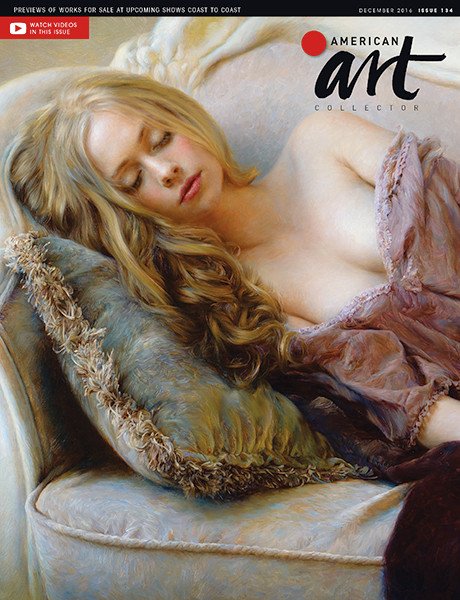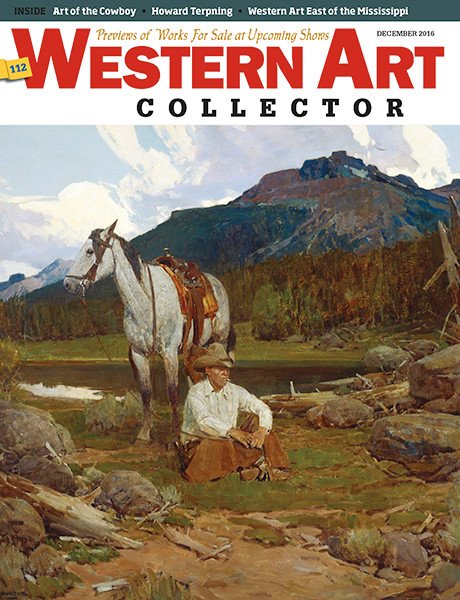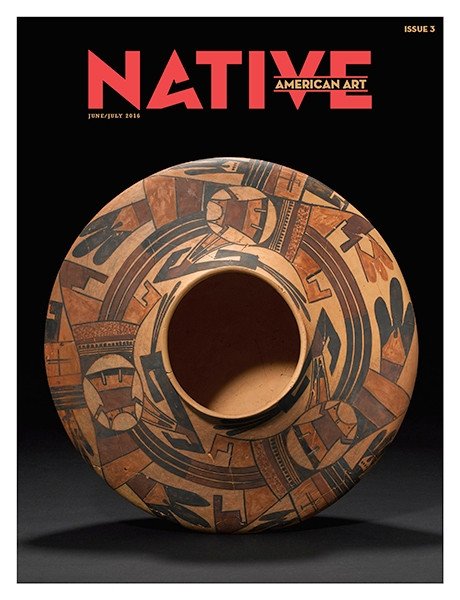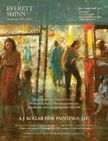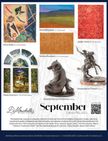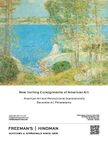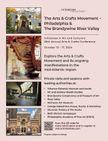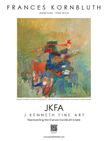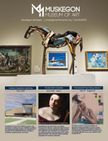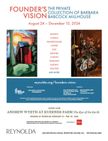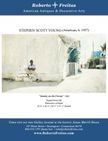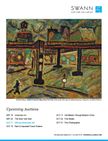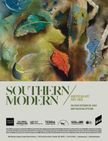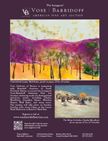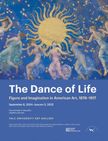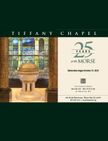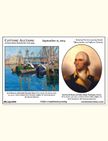For centuries, artists have relied on the support of wealthy patrons. But in 1938, the exclusive Robert C. Vose Galleries in Boston sold a painting to a very different type of collector—a high school in Springville, Utah, which displayed the picture in its annual Spring Salon. That a high school was holding yearly salons is surprising enough. Even more astonishing, the students raised the money to buy the painting by holding bake sales. (Mrs. Rothwell’s pies were particularly popular.)
 Leon Kroll (1884–1974), Girls at the Exhibition, 1964. Oil on board, 32 x 26 in. Springville Museum of Art. Gift of the 1965 Springville High School Senior Class.
Leon Kroll (1884–1974), Girls at the Exhibition, 1964. Oil on board, 32 x 26 in. Springville Museum of Art. Gift of the 1965 Springville High School Senior Class.
The movement that began at Springville High School in the 1920s still endures under the auspices of the Springville Museum of Art, and this year marks its 100th anniversary. To celebrate the milestone, the museum is holding a special retrospective called Salon 100, featuring 100 paintings and sculptures from the past century, plus a smaller installation of ephemera from the Salon’s early days.
 Joseph Henry Sharp (1859-1953), Playing the Game, ca. 1930. Oil on canvas, 36¼ x 30 in. Springville Museum of Art. Gift of the 1939 Springville Junior High School Eighth Grade Class.
Joseph Henry Sharp (1859-1953), Playing the Game, ca. 1930. Oil on canvas, 36¼ x 30 in. Springville Museum of Art. Gift of the 1939 Springville Junior High School Eighth Grade Class.
The high school may have been small, but the students managed to persuade some big names in representational art to send them paintings. Nationally known artists who exhibited their work there between the late 1920s and the 1950s include Robert Henri, Childe Hassam, J. Alden Weir, Edward Hopper, John Twachtman, Rockwell Kent, Georgia O’Keeffe and John Koch.

If the concept of placing museum-quality art in schools sounds odd today, it didn’t seem strange at the time. “With the progressive movement in education, there was a belief that having original art in schools made students better students,” says Emily Larsen, director of the Springville Museum of Art. Examination of the paintings and sculptures would encourage critical thinking, beyond the rote memorization that was integral to so much education at the time.
 Sven Birger Sandzén (1871-1954). Moonrise in the Canyon, Moab, Utah, 1928. Oil on canvas, 40 x 48 in. Gift of the 1928 Springville High School Junior Class.
Sven Birger Sandzén (1871-1954). Moonrise in the Canyon, Moab, Utah, 1928. Oil on canvas, 40 x 48 in. Gift of the 1928 Springville High School Junior Class.
The students became involved in every aspect of the Salon, writing to artists, helping to uncrate and hang the pictures, producing catalogs for the exhibition, and acting as guides for the thousands of visitors who flocked to the show. And lest any students try to ignore the artwork in their midst, English teachers foiled that intent with “the dreaded art theme”—a yearly requirement that students pick their favorite piece in the Spring Salon and write an essay about it. “The comments we’ve seen from former students are pretty moving,” says Larsen. “They found the art collection to be a place to unplug and reflect on its meaning.”
Each year the school would purchase one or two pieces from the Salon for its permanent collection. Until 1936, the burgeoning collection hung in the school corridors and auditorium. Then in 1937, Springville High School was able to open a museum, thanks to funding from the Works Progress Administration. The museum still remains in that 1937 building, with its Spanish colonial revival architecture.
 Paul Lauritz (1889-1975). Crashing Harmony, 1929. Oil on canvas, 50 x 60¼ in. Springville Museum of Art. Gift of the 1931 Springville High School Sophomore Class.
Paul Lauritz (1889-1975). Crashing Harmony, 1929. Oil on canvas, 50 x 60¼ in. Springville Museum of Art. Gift of the 1931 Springville High School Sophomore Class.
While the Springville Salon now focuses solely on Utah-based artists, the Salon 100 exhibition spans the previous century, with artists from across the country. Among the painters represented is Leon Kroll (1884-1974), who, in a long and varied career, painted landscapes, still lifes, murals and portraits. His 1964 Girls at the Exhibition shows a pair of teens with stern expressions, soberly assessing a picture. By showing the girls from hip-level up, Kroll draws attention to their faces and posture, emphasizing the seriousness with which they contemplate his paintings within a painting. For obvious reasons, it became a favorite with the students and is the signature image of Salon 100.
Another highlight is Playing the Game, circa 1930, by Joseph Henry Sharp (1859-1953), a founding member of the Taos Society of Artists. Sharp became known for capturing on canvas the traditional—and rapidly disappearing—lifestyle of Native Americans. Here, the warmth of the colors, combined with the rapt attention of the players, draws the viewer into the scene. Yet the turned backs of two of the participants, plus the fact that the game is not visible to us, underscore the divide that separates viewer and subject.
Not surprisingly, the show also includes a number of paintings depicting powerful Western landscapes, including Moonrise in the Canyon, Moab, Utah, 1928, by Sven Birger Sandzén (1871-1954). His vibrant colors and bold impasto combine to create the effect of air shimmering in the late afternoon heat, in a scene marked by torpor and stillness.
 Alma Brockerman Wright (1875-1952), Lady in Black, 1919. Oil on canvas, 36 x 28 in. Springville Museum of Art. Gift of Springville High School, 1922.
Alma Brockerman Wright (1875-1952), Lady in Black, 1919. Oil on canvas, 36 x 28 in. Springville Museum of Art. Gift of Springville High School, 1922.
The same cannot be said for the 1929 painting Crashing Harmony by Paul Lauritz (1889-1975), a coastal scene in which roaring ocean waves pound the rocks on the shore. The evocative title makes viewers pause to listen, if only in their imagination, for the dynamic harmonies of the wind and waves.
In compiling the show, the curators could hardly overlook the first painting the students ever purchased—the intriguing 1919 portrait Lady in Black by Alma Brockerman Wright (1875-1952). Later generations would claim—without evidence—that the sitter was a young Margaret Hamilton, the actress who played the Wicked Witch of the West in the film version of The Wizard of Oz. It seems unlikely that Hamilton was the model, yet there is something mysterious about this woman. Why is she wearing a style of hat that was not in fashion in 1919? And what has made her pause in the act of taking off her gloves—one glove off, one on—and turn a partly shadowed face to the viewer?
 William Sergeant Kendall (1869-1938), Three Portraits (The Artist’s Wife and Daughters), 1906. Oil on canvas, 60 x 40 in. Springville Museum of Art. Gift of the 1938 Springville High School Junior Class.
William Sergeant Kendall (1869-1938), Three Portraits (The Artist’s Wife and Daughters), 1906. Oil on canvas, 60 x 40 in. Springville Museum of Art. Gift of the 1938 Springville High School Junior Class.
But the painting that seems to beckon to people from across the room is the one that the students purchased from Vose Galleries in 1938—William Sergeant Kendall’s 1906 Three Portraits (which the museum has renamed The Artist’s Wife and Daughters). Kendall painted this work as a gift for his wife, Margaret Stickney Kendall, and the title Three Portraits shows that to him it was not just a figure painting, but three individual portraits of the most important people in his world: his wife and the couple’s two daughters, Elisabeth and Beatrice.
Kendall, who trained in New York, Philadelphia and Paris, would go on to serve as the director and then dean of the Yale School of the Fine Arts from 1913 to 1922. This painting shows his mastery of composition and technique—for example, in the soft drape of the fine cotton day dresses, the gentle touch of the mother’s and younger daughter’s fingers, the subtle blend of cream and white tones, and the slightly off-center placement of the family, balanced by the vase of three irises.
 Installation view of Salon 100 at the Springville Museum of Art. The 1937 building was designed in the Spanish Colonial Revival style.
Installation view of Salon 100 at the Springville Museum of Art. The 1937 building was designed in the Spanish Colonial Revival style.
But what struck many students over the years was not so much his painterly technique as the three subjects’ eyes. When Kendall painted his wife, it was usually in profile, inclining her head tenderly toward one of her children, watching the girls play, reading to them or observing them from the shadows. On this occasion, however, he showed her full face, with her unusual eyes—one blue, one brown. Margaret Kendall did in fact have mismatched eyes, as family photographs attest. Interestingly, the small child in her lap (Beatrice) inherited blue/gray eyes, and the older kneeling girl (Elisabeth) inherited brown ones, as shown in the painting.
 Leland S. Curtis (1897-1989), Sierra Dawn, 1931. Oil on canvas, 40 x 48 in. Springville Museum of Art. Gift of the 1932 Springville High School Junior Class.
Leland S. Curtis (1897-1989), Sierra Dawn, 1931. Oil on canvas, 40 x 48 in. Springville Museum of Art. Gift of the 1932 Springville High School Junior Class.
Over the years, the picture has served the students not only as an object lesson in genetics and the complexity of eye color, but also as a cause for reflection. “One former student gave an incredible account of how it made him think about the nature of families and what is transmitted from one generation to the next,” says Larsen. “Years later, it was the painting he found most memorable.”
It’s a legacy to be proud of.
Anne Underwood is a longtime writer and editor for a variety of publications. She is a great-granddaughter of William Sergeant Kendall and is currently writing a book on him.
Powered by Froala Editor
